I always had a vague interest in the idea of following up my family tree. I knew my maternal uncles had done quite a bit, and I had made sporadic attempts to put something together now and then, picking my mother’s brains. Eventually, I decided to make a start myself. This was the beginning of my addiction!
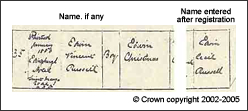
I started off on my mother’s tree with the name CHRISTMAS, it was immediately attractive, plus I knew that a start had been made. I listed a lot of the records I found in the General Records Office indexes, I also spent a lot on 1901 census vouchers, because I hadn’t succumbed to the temptation of Ancestry membership at that stage. I’d known about my great uncle Cecil who’d died in the Great War but when I came to look for a birth registration to go with his name and age on the 1901 census, I could find only Edwin Cecil R CHRISTMAS. That is when I thought that I must have found an unsuspected twin Edwin Vincent R CHRISTMAS.
I applied for both certificates from the GRO using their online facility and sat back (impatiently) to wait. They arrived separately, but ended up with two copies of the same certificate. That was when I discovered about Column 10 – the one at the end where a new or revised name is placed. That has its own registration number, but in the form of an adjacent number with ‘a’ attached to it (2c-24a, the updated name, to go with 2c-25, the original name). I complained to the GRO about the duplication and they explained that because the certificates had been sent out separately, there had been no opportunity to see that there were two copies of the same one. They refunded me as soon as I returned the extra certificate.
I then found Cecil’s medal card image on the National Archives of the United Kingdom website and also found him listed on the Commonwealth War Graves Commission’s website too.
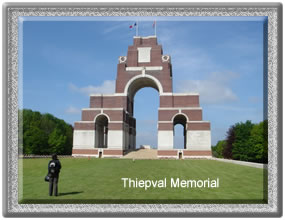
Edwin Cecil R Christmas was killed at Thiepval on 7 October 1916 in part of the carnage that was the Battle of the Somme. His was one of the bodies which were never found, so his name is on the great Lutyens memorial on the hilltop there.
The CWGC’s Debt of Honour register records details of the casualty including age and the names of their parents and spouse, but he was just ‘age unknown’ with no family mentioned. I felt as if he were somehow orphaned, and I was determined to get him afforded some more details on his record.
I contacted the CWGC by email. I explained that I had a copy of my great uncle’s birth certificate and asked if they would enter his age in their records. This proved more complicated than I’d expected. It is such an unusual name that there couldn’t have been two of the same, however they still wanted some evidence that the birth certificate in my possession was the same person as their record of a lieutenant in the Kings Royal Rifle Corps. They told me that “The commission is always willing to consider amendments to the records, however before we can add names of parents or ages to the records of any of our casualties, we need a copy of the casualties birth certificate, and also some documentary evidence connecting the birth certificate with the casualty, this could be a memorial card or obituary notice etc. The reason for this is that we must be sure that the birth certificate does refer to the casualty commemorated by the commission”. Logically, they were right, an unusual name is no guarantee of uniqueness, but it was still exasperating. They needed his service record (if it had survived), a newspaper obituary or his name mentioned on a local monument, something to make that connection. The investigation had begun!
I contacted the Royal Green Jackets museum. The curator was very helpful in sending me copies of records in which my great uncle’s name had been mentioned: ‘Officers Died in the Great War’ and two extracts from ‘The King’s Royal Rifle Corps Chronicle’.
I then tried the 1914-18 website on The Long, Long Trail and found out about where the battle had been fought and its context. However I still had nothing to join my certificate, along with the 1901 census record, to the soldier who had been killed.
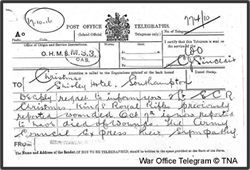
Suddenly I had the opportunity to visit the National Archives at Kew in London to see if his record were there and whether it was one of those which had survived the WW2 bombing. I was a bit dazzled at first by all the resources there, but did manage (with the aid of a relevant leaflet) to work out where I should look. I found Cecil’s name on the microfilm and this gave me the necessary reference information to ask to see his record, which had indeed survived. The lists are in alphabetical order, so I couldn’t resist asking for my grandfather’s record too when I saw his name a line or two further down. Soon, I was sitting at one of the tables, leafing through the records of my grandfather’s and his elder brother’s service records. My great uncle was always known as Cecil, presumably because it would have been too confusing to use his first name Edwin, as that was the same as his father’s. How was I going to be able to confine myself to the small number of photocopies I could ask for at one sitting? I wanted copies of my grandfather’s service record too. In the end I settled for copies of my great uncle’s record, and making notes from my grandfather’s.
The experience of reading those records was very special. I had known my grandfather was involved in the later part of WW1 in the Labour Corps, but I hadn’t realised that he had fought on the Somme too, in a different regiment from his brother. He had been seriously injured on the same day that his brother had been killed. My grandfather had died in 1981 and being that his brother was only nine years older, then I should have been able to meet him, but had been robbed of this opportunity by war. That proved to me a more powerful anti-war message than all the impressive statistics and the anti-war films and documentaries I have ever seen.
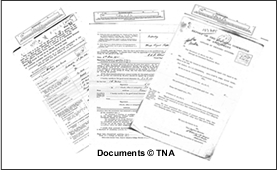
I came home with a bundle of copies, showing the same next of kin and birth details as the birth certificate. I now had all the information I needed to link the service record to the birth certificate and to the record on the CWGC’s web site. I sent them all my evidence, but they said that E C R Christmas couldn’t be the Edwin Vincent Russell Christmas because of the amendment in column 10 of his birth certificate. Fortunately, I managed to convince them with the logic that the name in column 10 was more likely to be the one used than the name in column 2. I had the satisfaction of hearing from them that they were to add his age and parents details to his record on the next update. His record now shows that he is no longer an ‘orphan’ with no age.
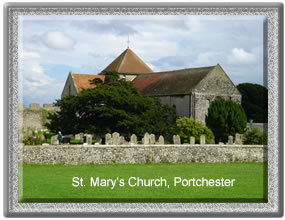
Some months later in the late spring of 2005, we planned one of our holidays so that we could visit Thiepval Memorial. I wanted to see my great uncle’s name on the monument. By that time I had also been in touch with my grandfather’s regimental museum. He served in the Yorkshires, which is now part of the Green Howards. I wanted to know what my grandfather’s regiment would have been doing so that he was wounded on the same day as his brother was killed. The curator there was also very helpful and they sent me a copy of the regimental war diary. Some of these are now available on the National Archives website.
As we drove south down the autoroute to our first stopping place at Albert, I took a moment to read the war diary for the dates when my grandfather was arriving in France to see that his first billet was also at Albert! Perhaps I should not have been surprised, because it’s a logical place to be as a centre of activity, but yet there was something resonant about it.
Our first attempt to visit the monument on a rainy Saturday was thwarted by the cleaning which was going on in preparation of the 90th anniversary in July 2006, so we went back on the Sunday morning. The weather had cleared unexpectedly, and the sky was clear and blue.
I noticed as I walked towards that great monument, that the time was just coming up to 11 am, there seemed no more appropriate time of day when I could have visited. I found his name engraved on the wall and gazed at the other thousands of names there too, each one representing a life lost, without even a body to be buried.
In February 2005 I found that I might have circumvented some of that effort. A very kind Genes Reunited member visited the graveyard of Portchester to look up some members of my Russell family for me. I’d also mentioned the CHRISTMAS connection in passing. Not only did she find the graves of Cecil’s parents (my great grandparents) she also found his name on a plaque on the wall of the church and this inscription on his parents’ gravestone –
EDWIN C.R. CHRISTMAS (CECIL) 2ND LIEUT KINGS ROYAL RIFLES
SON OF MARGARET & EDWIN
DIED OF WOUNDS RECEIVED FRANCE OCTOBER 8TH 1916 AGE 30 YRS.
I’ve now been to see it for myself. I’m glad that I didn’t short-circuit the process though. The whole experience has been so interesting, and I would have missed all the thrill of the chase, as well as the fascinating experience at Kew. Perhaps I should go back there again, now that I know that you’re allowed to take your own digital photos of the service records instead of being limited to a small number of photocopies.
Christine in Herts
© Christine in Herts 2007